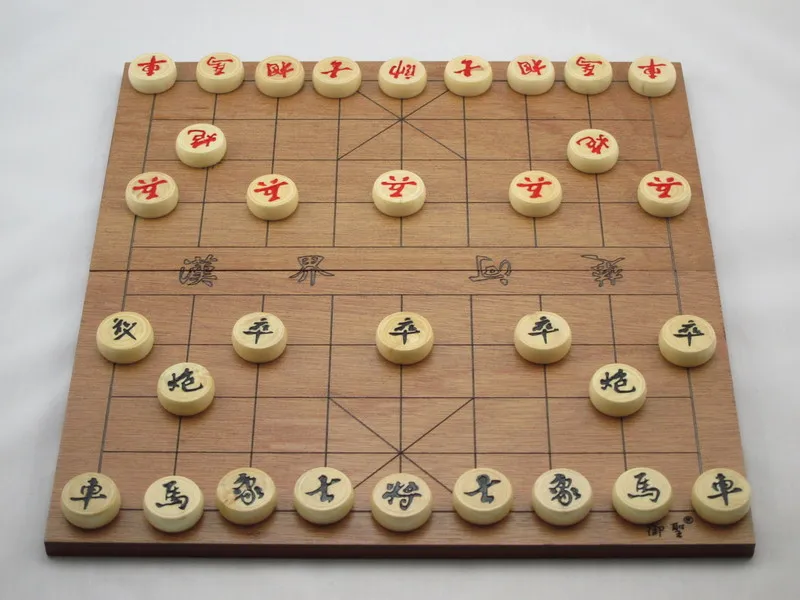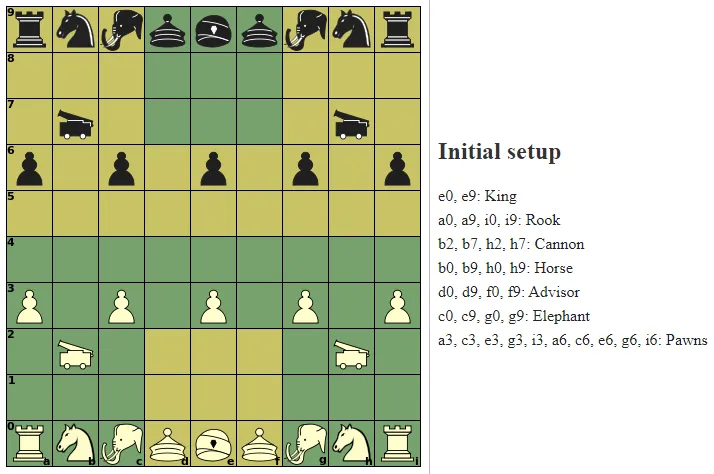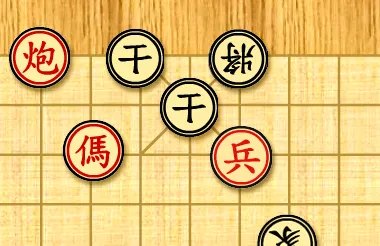Dear chess fans and all others!
this week is a break from the Hivechess Friday tournament, so maybe you have time to check out this:
The chinese variant of chess, Xiangqi (象棋), is almost completely unknown in the Western world, even to many chess players, but in China it is extremely popular, in fact the most popular board game over there, also in Vietnam and Taiwan it is frequently played. By the number of players it is even more common than "our" chess (for simplicity just called chess from now on).
It is not known, when exactly it was invented. Probably it originated, like the predecessors of all chess variants, in North India, where this "original chess" was called Chaturanga and was already known since the 6th century AD!
The Chinese variant Xiangqi appeared shortly after that and since the 12th century the rules of the game have not changed! Thus there is an extensive literary fund of especially opening and endgame literature about this game, which even surpasses that of chess! These textbooks often have typically poetic names like "collections of flowers from the peach tree". However, a modern, systematic opening library like we have in chess was created only in 2004.
Unlike chess, in China it is desirable for an educated person with status to be good at Xiangqi!
The game board consists of ten horizontal lines and nine vertical lines. Instead of placing the pieces in the squares, they are placed on the intersection points of the lines, like in Go, so that there are 90 possible positions, compared to the 64 in chess. Of note, there are no white and black squares.
The starting position:

https://en.chessbase.com/post/why-you-need-to-learn-xiangqi-for-playing-better-chess
In Xiangqi, two armies symbolically fight against each other. The "palace" or "fortress", 9 positions in each player's base marked by diagonal lines, house the kings (rather called generals) and their two advisors/guards. The so-called "river" divides the board in the middle. It supposedly comes from a river that acted as a border between two hostile empires after they went to war with each other (possibly it was the Battle of the Wei River, in which the Qi Empire was defeated by the Han Empire in 203 BC).
The two opponents each have black (rarely green) and red pieces (red has the first move), and there are not three-dimensional pieces as in chess, but round discs whose meaning is printed in the form of characters - one of the reasons why the game has not yet caught on in the West. There are also Europeanized representations that at least give hints about the possible moves of the pieces (rook, knight), but for the true connoisseur these are frowned upon.
Europeanized visualization (with pieces on fields instead of the intersection points of the lines):

https://www.gnu.org/software/xboard/whats_new/rules/Xiangqi.html
The pieces
General
Unlike in chess, the opponents have differently named pieces, but both - general (black) and marshal (red) - follow the same move rules: one step horizontally or vertically (not diagonally). They correspond - not hard to guess - to the king in chess, but unlike in chess, the general may never leave the palace, so has a total of only nine possible positions. There is also no castling. But there is an interesting long-distance effect - the "death look". The two kings may never face each other freely on a line, without an intervening piece. Obviously, this can become very important in the endgame, because one king can block a whole line to the other (moving the king to a threatened square is forbidden, just like in chess)!
Advisor
The two advisors, also called mandarins or guardians stand in the basic position to the left and right of the general and, like him, may never leave the palace. Since they can only move one square diagonally each, they have only 5 possible positions (the center and the 4 corners of the palace). So the only diagonal lines on the board show not only the palace, but also the move possibilities of the mandarins!
Ministers / Elephants
The two ministers (red) and the elephants (black), usually simply called elephants, are the namesakes of the game ("xiàng" = elephant), which could be also translated as "elephant chess". They are like weak bishops in chess, since they can move diagonally, but only exactly 2 squares, and only if the skipped first square is free. Since they are not allowed to cross the river, they are considered purely defensive units. A strong queen as in chess does not exist in Xiangqi, supposedly reflecting the low status of women in China in ancient times.
Horses
Next to the elephants in the starting position are the horses. These correspond to the knights in chess, but move first one square horizontally and then one diagonally, whereby, as with the elephant, the skipped first square must be free. Therefore, they cannot jump at all.
Chariots (Rooks)
The chariots, initially located at the corners of the board, move in exactly the same way as the rooks in chess. They develop their full strength only during the course of the game (just like the horses), when there are fewer pieces on the board to hinder them.
Cannons
The cannons, which exist only in the Chinese variant, are the most interesting pieces. They move like rooks, but like a catapult they can hit an opponent's piece by jumping over another piece (whether red or black), the so-called "cannon platform" or "screen", over any distance, and also no matter where on the line the cannon platform is located. The strength of the cannons tends to decrease as the game progresses, since fewer and fewer cannon platforms are available. Right from the starting position a player can exchange a cannon for a horse (but that would be not advisable).
Soldiers
The five soldiers correspond most closely to the pawns in chess, but are much more powerful. The number five could stand for the five elements of Chinese philosophy (wood, fire, metal, water and earth). They move one square forward, but as soon as they reach the opponent's side of the river, they are kind of promoted and can also move one square to the left or right (but never diagonally or backwards).
Unlike in chess, they do not capture diagonally, but in the same way as they move, i.e. forward and in the opponents´ half also sideways, which makes them important offensive pieces (you cannot block them simply by placing a piece in front of them like in chess). They are also quite useful as cannon platforms.
Soldiers cannot promote into more valuable pieces after reaching the enemy baseline, supposedly this corresponds to the rigid social hierarchy in China.
Mate / Stalemate
The objective of the game is to checkmate or stalemate the opponent's general. Yes, unlike in chess, stalemate is not a draw, but is considered a victory for the side that can still move.
If a player is checked, there are four reaction options in Xiangqi. In addition to the three that also occur in chess (evade, capture the threatening piece, or place an own piece in between), the fourth option is to remove an own cannon platform so that an opponent's cannon is no longer threatening (see example). If all four options fail, a player is mated and has lost.

https://en.wikipedia.org/wiki/Xiangqi
Example of mate: The red cannon on the top left threatens to hit the general (black) on the next move. Evading the general to the left does not change anything (the cannon can hit this square as well), moving down is not possible because this square is threatened by the red soldier, a diagonal evasion is not possible because the own mandarin is in the way and leaving the palace is not allowed. As a last resort, the own mandarin, which was involuntarily used as a cannon platform by the opponent, could move away, but he is only allowed to move diagonally inside the palace and his only possible move is obstructed by the other mandarin. Therefore mate.
By the way: Giving perpetual check, e.g. to obtain a draw, or other move repetitions - not uncommon in chess - are forbidden in Xiangqi! The repeater must change his plan, because the third repetition leads to a loss! However, the move repetition rules are relatively complicated, because if both players repeat the position, a draw is possible.
A draw by agreement is also allowed.
Game characteristics
Compared to chess, Xiangqi is faster and more aggressive. Due to the fact that the soldiers do not block each other as in chess, there are no closed positions and much less lengthy positional play, but more often a quick king attack. Moreover, with the same number of pieces (16 each), there are 90 squares instead of 64, which makes the game more "open", with a shorter opening phase.
Since, unlike in chess, the kings are in mirror symmetry exactly in the center, there is neither a king´s side nor a queen´s side. Since there are also no queens and bishops, diagonals are generally much less important in Xiangqi than in chess. Instead, the cannons allow for tactical possibilities unusual to chess players, such as the "double cannon" (one cannon using the other cannon as a platform). Typical tactical motifs of chess such as sacrifice, fork, pin or discovered attack also occur in Xiangqi.
More pronounced than in chess, the strengths of the individual pieces can change depending on the phase of the game. Chariots and horses become stronger the fewer pieces are on the board, while cannons become weaker. All three are the active pieces, useful in attack and defense; in contrast, the advisors/mandarins and the elephants, which must remain in their own half, are purely defensive pieces. Soldiers are the third group. The closer they are to the enemy palace, the more important they become. It is said that a soldier in the enemy palace is worth as much as a chariot. Soldiers are also willingly sacrificed for an attack.
Of central importance is to gain and keep the initiative. Whoever has the initiative is in the "upper hand", the defending opponent has the "backhand". It is possible to gain the upper hand from the defense by a sacrifice (or a weak move by the opponent), but it must be well considered in the case of a sacrifice whether the initiative gained compensates for the material lost.
So much for the theory - ready for practice?
Here you can play online against a Xiangqi computer:
http://xahlee.info/chinese_chess/chinese_chess.html
For simplicity, here is the wimp variant with europeanized pieces:
http://www.springfrog.com/games/chess/chinese/
I tried it out and first memorized the meaning of the pieces. With a bit of practice, that went reasonably well. Nevertheless, in the first games I was completely torn apart, because I didn't pay enough attention to the move possibilities. That the horse can't jump and "pawns" can move sideways beyond the river is something you have to remember. Not to mention the sneaky cannon! And the limited move possibilities and restrictions of pieces within the palace makes it much harder for a chess player to cover his own pieces. So patience is required at the beginning!
One of the strongest non-Chinese Xiangqi players is the German chess grandmaster Robert Hübner. Hübner took part in the Xiangqi World Championship in Beijing in 1993 and achieved a highly regarded 36th place among 76 participants!
Xiangqi - popular earlier...

http://www.xqinenglish.com/index.php/en/
...and today as well!

https://www.flickr.com/photos/alidasphotos/48885021342/
Someone suggested that you try unpacking a Xiangqi board in a Chinese restaurant of your town after dinner and playing it with a friend! Within a short time, every employee will come by and want to see that. That would certainly be an interesting experience :)
Who of you has ever played Xiangqi?
Sources:
https://en.wikipedia.org/wiki/Xiangqi
https://sites.google.com/site/caroluschess/chess-and-game-variants/xiangqi
https://en.chessbase.com/post/why-you-need-to-learn-xiangqi-for-playing-better-chess
Taken from an old post of mine in German on that former blockchain and brought to Hive and translated using mostly deepl.com
